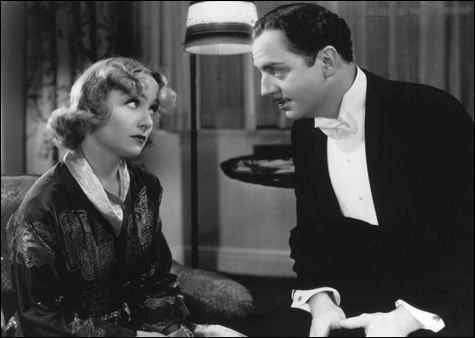
MY MAN GODFREY: This one’s ’30s-style eccentricity is hugely entertaining. |
| “Carole Lombard: No Dumb Blonde” | Brattle Theatre: October 18-23 |
Carole Lombard rose to stardom in 1934 and was dead by 1942, killed in a plane crash on her way back from selling war bonds; her last picture, Ernst Lubitsch’s To Be or Not To Be, was released posthumously. She was one of the great funny girls of the Depression era, as witness the five features in the Brattle’s upcoming series “Carole Lombard: No Dumb Blonde” (October 18-23). Her compact but pointed face, the soft blond crown of hair, the sleek, elegant frame that satin and silk and lamé either clung to or dripped off, all made her a ’30s icon — the billboard for her 1936 film Love Before Breakfast is at the center of one of Walker Evans’s photographs. In straight pictures she was competent and always lovely, but she was at her best in comedies, where she could add a goofy quality to her glamor.The films in the series include her three finest — TWENTIETH CENTURY (October 19-20), MY MAN GODFREY (October 18 + 23), and NOTHING SACRED (October 21-22) — as well as her two last, MR. & MRS. SMITH (October 21-22) and TO BE OR NOT TO BE (October 19-20). Twentieth Century, superbly directed by Howard Hawks from a breakneck script by Ben Hecht and Charles MacArthur, came out in 1934, the year the Production Code went into effect and filmmakers invented romantic comedy as a way of negotiating the creative restrictions it placed on them. It’s a mixture of romantic (screwball) and backstage comedy. Lombard plays Mildred Plotka, a lingerie-model-turned-actress who lands the lead in a Broadway play because producer Oscar Jaffe (the inimitable John Barrymore) — who promptly renames her Lily Garland — is convinced he can turn her into a sensational actress. He succeeds, and they become partners, on stage and off. But his megalomania and jealousy eventually drive her away — to Hollywood, where she becomes an even bigger star. The movie, most of which takes place three years later on board the Twentieth Century, the cross-country train that was all the rage in the period, is about a pair of battling egomaniacs who can’t distinguish between theater and life; even when Lily bemoans her own penchant for unending melodrama, she’s playing a scene.

This was the role that made Lombard a star. It enabled her to perfect her comic equipment: the silver-frosted alto voice that floats up when she gets excited; the eyes that can fix fervently on a romantic object or zip around like marbles in a pinball machine; the perfectly pitched diva-style tantrums; the seemingly bottomless repertoire of stylized gesture. Screaming that everyone keeps hammering at her, she drills at her temples with balled-up fists while she stamps her feet, looking like one of those wind-up monkeys that play a tin instrument. Lombard and Barrymore are an inspired pair of lunatic monsters. No movie captured the excesses of theater people with as much hilarity until All About Eve and Singin’ in the Rain in the early ’50s.
My Man Godfrey, from 1936, is an essential Depression comedy, and it has the performance Lombard is best known for. She’s the ditzy heiress Irene Bullock, who wins a Park Avenue scavenger hunt by showing up with a “forgotten man” from an East River Hooverville (played by William Powell), gets her parents to hire him on as a butler, and falls in love with him. Although the movie is screwball, it doesn’t follow the arc of conventional romantic comedies of the period. There’s no real courtship, no compromises that lead the protagonists into each other’s arms after an initial adversarial period. They wind up together because the heroine (like Katharine Hepburn in Bringing Up Baby) is an irresistible force and the hero simply stands still long enough for her to bowl him over and hogtie him. (“Don’t worry, Godfrey, it’ll all be over in a minute,” Irene advises him before the final fadeout.)
The movie is directed by Gregory La Cava, who learned his craft in silent comedy; his training shows in the way he can orchestrate grandiose chaos (the scavenger hunt sequence) and sculpt a small-scale farce scene like Godfrey’s serving dinner to the Bullock family even though he’s so plastered he can’t stand up straight. The screenplay by Morrie Ryskind and Eric Hatch has a soft-candy center. We like Irene because, though she’s absurdly entitled and fakes nervous breakdowns when she doesn’t get her own way, she’s infinitely more humane than her older sister, Cornelia (Gail Russell), a sultry bitch who tries to frame Godfrey for the theft of her necklace — and even Cornelia capitulates to him in shame at the end. But the film’s ’30s-style eccentricity is hugely entertaining — this family are a lot more fun to look at than the more lovable nutcases in Capra’s You Can’t Take It with You — and it’s a joy to watch the debonair Powell, his face a picture of bemused tolerance, play scenes with Lombard, who’s like a persistent but mesmerizing child. She reads her lines, some of which are prize loonies, in a quizzical tone, at a slightly sped-up pace, and she doesn’t always pause for the answer, or maybe she does but then she starts in again before he can quite finish. It’s overlapping dialogue that goes only one way. And her eyes sparkle; the lamé gowns set them off.